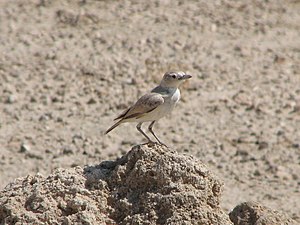Namibian Lark
| Namibian Lark | ||||||||||||
|---|---|---|---|---|---|---|---|---|---|---|---|---|

Namibian Lark |
||||||||||||
| Systematics | ||||||||||||
|
||||||||||||
| Scientific name of the genus | ||||||||||||
| Ammomanopsis | ||||||||||||
| Bianchi , 1905 | ||||||||||||
| Scientific name of the species | ||||||||||||
| Ammomanopsis grayi | ||||||||||||
| ( Wahlberg , 1855) |
The Namib lark ( Ammomanopsis grayi ) is a kind from the family of larks. Its distribution area is in the southwest of Africa and limited there to the Namib Desert , where it is one of the characteristic bird species. It is the only recent representative of its genus. There are two subspecies.
The IUCN classifies the Namiblark population as not endangered ( least concern ).
features
The Namiblark reaches a body length of about 13.9 to 16.3 centimeters, of which 5.1 to 6.1 centimeters are on the tail. The beak length is measured from the skull 1.39 to 1.63 centimeters. There is no noticeable gender dimorphism .
The Namibian lark is one of the brightest colored lark species. The top of the body is sand colored and in some individuals may have a slightly reddish tone. The sides of the head and the underside of the body are white. The chest and belly have a slightly sand-colored tone. The hand and arm wings are pale gray-brown. The beak is gray with a dark tip. The iris is olive brown.
Possible confusion
Due to its lack of chest markings, the Namibian lark should not be confused with any other species of lark. From a distance it bears a distant resemblance to the Oranjeschmätzer ( Cercomela tractrac ). Compared to this, however, the Namiblark is somewhat smaller and has a shorter and thicker beak. It also lacks the white rump that is characteristic of the orange tart.
Distribution area and habitat
The distribution area of the Namiblark is the Namib, a dry desert on the west coast of Africa. As a typical coastal desert , a strip along the coastal region is a so-called fog desert , in which the Namiblark occurs. The coast-parallel or offshore trade winds that are warmed over the continent and create so-called upwelling areas off the coast are responsible for the formation of fog in this desert strip . These winds push warm surface water away from the coast, allowing cold deep currents to rise and replace the warm water. Through contact with the cold water of the Benguela Current, the air near the surface also cools down and begins to condense. This cooling effect leads to high humidity in a strip many kilometers wide and thus to fog formation, so that there are around 250 foggy days per year.
The Namib Desert can be found in this coastal strip on light reddish stony surfaces with sparse grass cover and low succulents. With its plumage it is adapted to the weathering debris of the Namib desert.
Way of life
The Namibian lark often evades the heat of the day by retreating into a rodent burrow or to a shady place between stones or hanging branches. The diet consists of seeds, to a lesser extent also green plant material and invertebrates. The proportion of the individual food components fluctuates seasonally.
Like all larks, the Namibian lark is a ground breeder. There is no clearly defined breeding season. Nests and young birds are recorded for all months of the year.
literature
- Rudolf Pätzold: The larks of the world. Westarp Sciences, Magdeburg 1994, ISBN 3-89432-422-8 .
- Rudolf Pätzold: Compendium of Larks. All the larks on earth. Jan-Schimkat-Medienpublikation, Dresden 2003, ISBN 3-00-011219-7 .
